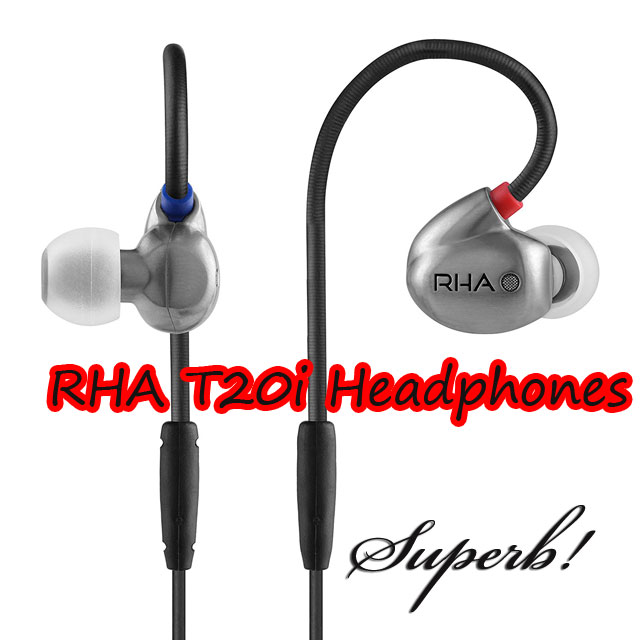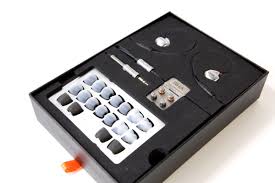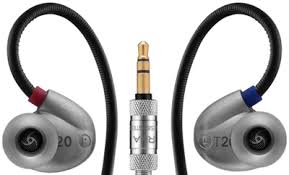RHA T20i Headphones

 RHA is a niche audio company headquartered in Britain. The RHA T20i in-ear universal fit headphones that retails for $249.95 ( www.rha-audio.com), and are also in the same league as the Japan-based Elecom SH-1000SV dual driver IEM ($300, elecom.net), the China-based Dunu Topsound DK-3001 IEM ($300, dunu-topsound.com), and the US-based Noble headphones. They are also the same league as the more conventional audio brand, Shure, which has the one-driver SE315 ($199, shure.com), the two-driver SE425 ($299), and the triple driver SE535 ($499).
RHA is a niche audio company headquartered in Britain. The RHA T20i in-ear universal fit headphones that retails for $249.95 ( www.rha-audio.com), and are also in the same league as the Japan-based Elecom SH-1000SV dual driver IEM ($300, elecom.net), the China-based Dunu Topsound DK-3001 IEM ($300, dunu-topsound.com), and the US-based Noble headphones. They are also the same league as the more conventional audio brand, Shure, which has the one-driver SE315 ($199, shure.com), the two-driver SE425 ($299), and the triple driver SE535 ($499).
 The RHA T20i in-ear headphones arrived in a durable rectangular box. Within the outer box is a firm inner box equipped with a fabric tab, which makes it easy to pull out from the exterior package. The inner box is open on the top and packed with dense fitted foam, which forms placeholders for the in-ear headphones, the tuning filters and their stainless steel holder, and the ten ear tips of varying shapes, sizes and materials, and their stainless steel ear tip holder. The fitted foam can be pulled out from the inner box, and below is space for the carry case, clothing clip, and user guide. Because the T20i comes with so many great accessories, it is useful that the packaging is so durable. I anticipate keeping it to store all the accessories that I won’t regularly use, like the extra ear tips and the manual. The carrying case is also very useful not only to keep the headphones clean and free of tangles, but also to store anything that I may want to use regularly, like the tuning filters. The carry case is made of padded faux leather and is secured by a zipper, which encircles three of the case’s four sides.
The RHA T20i in-ear headphones arrived in a durable rectangular box. Within the outer box is a firm inner box equipped with a fabric tab, which makes it easy to pull out from the exterior package. The inner box is open on the top and packed with dense fitted foam, which forms placeholders for the in-ear headphones, the tuning filters and their stainless steel holder, and the ten ear tips of varying shapes, sizes and materials, and their stainless steel ear tip holder. The fitted foam can be pulled out from the inner box, and below is space for the carry case, clothing clip, and user guide. Because the T20i comes with so many great accessories, it is useful that the packaging is so durable. I anticipate keeping it to store all the accessories that I won’t regularly use, like the extra ear tips and the manual. The carrying case is also very useful not only to keep the headphones clean and free of tangles, but also to store anything that I may want to use regularly, like the tuning filters. The carry case is made of padded faux leather and is secured by a zipper, which encircles three of the case’s four sides.
 The T20i comes with six sets of RHA’s dual density ear tips in enough sizes meant to fit all ear shapes and sizes for a comfortable and noise isolating seal. The ear tips are made of a softer outer layer and a firmer core. Also included are two sets of memory foam tips and two sets of double flange tips. With all of these choices, one would think that there is a fit for everyone. However, I initially did have trouble finding the right tips for my ears. Eventually, after trying all of them I found that the only tips that reliably stayed sealed were the large double flange tips. It could be that my ears are a particularly odd shape, but for me none of the single flange tips no matter the size, could stay sealed. Once I did find that the double flange tips worked for me, I noticed that they were reliable in terms of isolation from background noise, but that they were not the most comfortable. The moldable over-ear hooks are made of a malleable steel spring, which is covered with rubber. The hooks themselves can be molded into any position, thus forming and maintaining a shape over any ear size. This unique aspect does indeed make the headphones feel very secure.
The T20i comes with six sets of RHA’s dual density ear tips in enough sizes meant to fit all ear shapes and sizes for a comfortable and noise isolating seal. The ear tips are made of a softer outer layer and a firmer core. Also included are two sets of memory foam tips and two sets of double flange tips. With all of these choices, one would think that there is a fit for everyone. However, I initially did have trouble finding the right tips for my ears. Eventually, after trying all of them I found that the only tips that reliably stayed sealed were the large double flange tips. It could be that my ears are a particularly odd shape, but for me none of the single flange tips no matter the size, could stay sealed. Once I did find that the double flange tips worked for me, I noticed that they were reliable in terms of isolation from background noise, but that they were not the most comfortable. The moldable over-ear hooks are made of a malleable steel spring, which is covered with rubber. The hooks themselves can be molded into any position, thus forming and maintaining a shape over any ear size. This unique aspect does indeed make the headphones feel very secure.
 With the neutral filters popped on to these in-ear headphones, the first thing I listened to was Lana Del Rey’s hit, Ultraviolence. In her music, I am often struck by the contrast of intimate introduction and verse, with the wall of sound that she creates in the chorus. This certainly is the case in Ultraviolence, and so I was interested to see how the T20i would perform with these timbral and dynamic differences. In the introduction and first verse of Ultraviolence, the clarity and richness of the strings really pop. Not only did I hear the depth and texture of the string timbre, but also I was able to hear – for better or for worse – each bow change and articulation of the strings. When the first chorus comes in with its wash of sound, the headphones again performed very well in terms of balance and blend. I also listened to Lana Del Rey’s Shades of Cool, initially with the neutral filters and then with the bass filters. With the neutral filters, the electric guitars in the introduction have wonderful brightness, and the clarity and immediacy of their articulation is really stunning. Because of the use of plucked instruments rather than bowed instruments, the texture in the introduction and verse are much less dense, and therefore when the voice comes in, it is highlighted.
With the neutral filters popped on to these in-ear headphones, the first thing I listened to was Lana Del Rey’s hit, Ultraviolence. In her music, I am often struck by the contrast of intimate introduction and verse, with the wall of sound that she creates in the chorus. This certainly is the case in Ultraviolence, and so I was interested to see how the T20i would perform with these timbral and dynamic differences. In the introduction and first verse of Ultraviolence, the clarity and richness of the strings really pop. Not only did I hear the depth and texture of the string timbre, but also I was able to hear – for better or for worse – each bow change and articulation of the strings. When the first chorus comes in with its wash of sound, the headphones again performed very well in terms of balance and blend. I also listened to Lana Del Rey’s Shades of Cool, initially with the neutral filters and then with the bass filters. With the neutral filters, the electric guitars in the introduction have wonderful brightness, and the clarity and immediacy of their articulation is really stunning. Because of the use of plucked instruments rather than bowed instruments, the texture in the introduction and verse are much less dense, and therefore when the voice comes in, it is highlighted.
 The headphones did a wonderful job here, separating the instruments from the voice, and bringing out the enunciation in the vocal line. Like in Ultraviolence, the chorus in Shades of Cool is a wash of blended sounds, in which the voice is meant to embed into the texture. The headphones performed very well in both settings, and I believe they gave an accurate representation of what was intended by the artist and the engineers. I did feel I wanted to hear a bit more bass generally in this song, and so I replaced the neutral filters with the bass filters and listened again. In the introduction, I felt that the plucked instruments did lack that vivid clarity I enjoyed with the neutral filters. However, the bass guitar and bass drum were much more satisfying in the chorus. It’s a luxury to have a variety of filters to choose from and I think the choice of which ones to use simply depends on preference. I am a listener who enjoys hearing very crisp articulation, so for me the neutral filters would be my choice over the bass filters, which offer richness in the lowest register at the cost of clarity of in upper registers.
The headphones did a wonderful job here, separating the instruments from the voice, and bringing out the enunciation in the vocal line. Like in Ultraviolence, the chorus in Shades of Cool is a wash of blended sounds, in which the voice is meant to embed into the texture. The headphones performed very well in both settings, and I believe they gave an accurate representation of what was intended by the artist and the engineers. I did feel I wanted to hear a bit more bass generally in this song, and so I replaced the neutral filters with the bass filters and listened again. In the introduction, I felt that the plucked instruments did lack that vivid clarity I enjoyed with the neutral filters. However, the bass guitar and bass drum were much more satisfying in the chorus. It’s a luxury to have a variety of filters to choose from and I think the choice of which ones to use simply depends on preference. I am a listener who enjoys hearing very crisp articulation, so for me the neutral filters would be my choice over the bass filters, which offer richness in the lowest register at the cost of clarity of in upper registers.
 Next, I listened to several tunes from Miles Davis’ groundbreaking album, Kind of Blue. I think it is fair to say that at any given point in this album, each instrument has a very particular role to play within the group. The roles may switch and rearrange themselves as the tunes progress, but there is ideally, always a hierarchy towards which the ear is drawn. For this reason, I was curious to hear how the headphones would perform under these circumstances, in which both instrumental separation and blend are paramount. Listening to Blue in Green with the neutral filters on, I did indeed hear in the introduction both clarity of timbres, and blend between the pizzicato bass and the piano. When the trumpet and brushes enter at the head, the headphones again do an excellent job highlighting the role of each instrument. Of course a great deal of this has to do with how the album was recorded and engineered, but in this case, I think the T20i do a superb job bringing out exactly what was intended. The headphones highlight the best qualities of live performance – specifically, the ability to hear subtleties of timbre and tone – while at the same time, they augment the clarity and exactness that is so wonderful about studio recording. This was particularly evident in the solos, and at the end, when the bass – unusual for this genre – closes the tune with the bow.
Next, I listened to several tunes from Miles Davis’ groundbreaking album, Kind of Blue. I think it is fair to say that at any given point in this album, each instrument has a very particular role to play within the group. The roles may switch and rearrange themselves as the tunes progress, but there is ideally, always a hierarchy towards which the ear is drawn. For this reason, I was curious to hear how the headphones would perform under these circumstances, in which both instrumental separation and blend are paramount. Listening to Blue in Green with the neutral filters on, I did indeed hear in the introduction both clarity of timbres, and blend between the pizzicato bass and the piano. When the trumpet and brushes enter at the head, the headphones again do an excellent job highlighting the role of each instrument. Of course a great deal of this has to do with how the album was recorded and engineered, but in this case, I think the T20i do a superb job bringing out exactly what was intended. The headphones highlight the best qualities of live performance – specifically, the ability to hear subtleties of timbre and tone – while at the same time, they augment the clarity and exactness that is so wonderful about studio recording. This was particularly evident in the solos, and at the end, when the bass – unusual for this genre – closes the tune with the bow.
Overall, if you’re looking for high quality in-ear headphones with extraordinary detail and subtly in all ranges, these are a great choice. I think the quality is suitable for any audiophile or professional musician. Although none of the ear tips worked perfectly for me, I would wager a bet that with the variety offered here, most people would find a seal that is comfortable for them. Similarly, the variety in filter choice caters to many different preferences. With the subtly and range of these headphones, I can recommend this piece of equipment both to the professional musician needing an in-ear monitor for live performance, as well as the serious audiophile wanting to hear the subtleties of high quality recordings.

mark abell
Specifications:
Revolutionary DualCoil™, stainless steel in-ear headphone
• DualCoil™ dynamic driver
• Injection moulded steel
• Tuning filters: bass, treble, reference
• 3-button remote and mic
• Mouldable ear hooks
• Reinforced OFC cable
• Premium ear tips and carry case
• 3 year warranty
• Free delivery
Price: $249.00
Stereo Times Masthead
Publisher/Founder
Clement Perry
Editor
Dave Thomas
Senior Editors
Frank Alles, Mike Girardi, Russell Lichter, Terry London, Moreno Mitchell, Paul Szabady, Bill Wells, Mike Wright, and Stephen Yan,
Current Contributors
David Abramson, Tim Barrall, Dave Allison, Ron Cook, Lewis Dardick, John Hoffman, Dan Secula, Don Shaulis, Greg Simmons, Eric Teh, Greg Voth, Richard Willie, Ed Van Winkle, Rob Dockery, Richard Doran, and Daveed Turek
Site Management Clement Perry
Ad Designer: Martin Perry





Be the first to comment on: RHA T20i Headphones